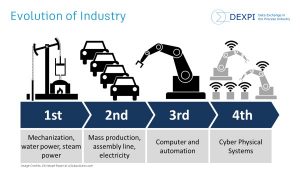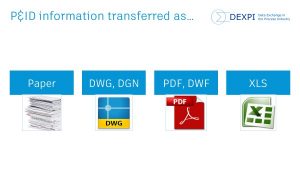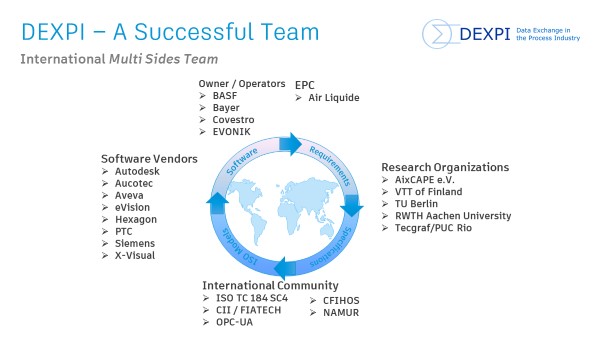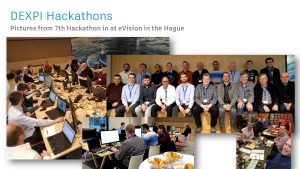Data Exchange in the Process Industry (DEXPI)
DEXPI is paving the way to Process Industry 4.0
Industry 4.0 is bridging the gap between two worlds: The physical world of machines and material flows – and the digital world with bits and bytes. Building and constantly maintaining a digital representation of the physical assets is a big challenge.
The Process and Instrumentation Diagram (P&ID) is the most important document used for designing and building a plant and must legally be kept as information base during operations. The definition of a common data exchange standard and an alignment of the industry’s terminology is a key factor for the transition from planning to building to operating.
Over the past decades the industry has seen a transformation from paper-based P&ID diagrams and plastic 3D models to digital drawings and models to intelligent digital data. The next step is the horizontal (across P&ID applications) and vertical (e.g. between P&ID and 3D applications) integration of these intelligent digital data.
The new way of designing a chemical plant is that it is no longer necessary to be in the same room with the colleagues to redline and discuss a flow diagram. Digital drawings are not only graphical illustrations but also include meta-data and references coming from other engineering systems or enterprise tools like ERP.
However, unfortunately, it is still also common that digital P&IDs are not exchangeable across software systems. For example, an Engineering Partner (EP) could plan and design a plant in one software solution for P&IDs. The owner and operator (O/O) of that plant most probably uses different software tools and thus cannot simply re-use the P&IDs created by the EP.
Converting the information between different software system formats is usually not possible out-of-the-box and it might sometimes even be required to completely redraw it. This means that intelligent digital data has a limited lifespan and there is no guarantee that it will survive software changes and be available in future for later usage.
Therefore, it is imperative to apply the Industry 4.0 ideas of open data exchange also to P&IDs.
In the industry, the DEXPI (Data Exchange for the Process Industry) initiative has developed a data format that supports the move from a document-centric to a data-centric approach, which is the current transition the industry is facing.
The DEXPI initiative was launched in 2011 by a group of owner and operators (BASF, Bayer, Evonik), software vendors (Autodesk, Aveva, Bentley, Intergraph, Siemens), research organizations (AIXCape, RWTH Aachen) and engineering companies (Air Liquide).
As of 2018, the number of members has grown significantly, and it is currently being implemented as a PAAT working group of ProcessNet, a DECHEMA and VDI organization. More information can be found at http://www.dexpi.org.
DEXPI Mission statement
We work to create an open, neutral and reliable data exchange standard for the process industry to establish a future-proof digitalized collaboration.
The software vendors in the DEXPI group understand that the owners and operators have an urgent need to better collaborate during the planning and operating phases of a plant. Using the DEXPI format makes it possible for owners and operators to select an EP even if they use a different CAE (Computer Aided Engineering) system, which eases some of the significant challenges the process industry faces when it comes to data handover.
With DEXPI as standard, the selection of an EP does not necessarily imply using the same CAE system and gives more flexibility.
In general, the process plant industry faces significant challenges when it comes to data handover. The ISO 15926 is an international standard framework for data exchange, but the framework itself it is to unspecific to be practically usable. As a consequence, many different specializations of ISO15926 have been derived. Unfortunately, without any alignment between each other.
The DEXPI format successfully uses and extends existing standards to deliver a practically usable format.
It enables workflows beyond P&ID design such as instrumentation, visualization, integration with 3D models and simulation, thus, paving the way to digitalization in the process plant industry.
All DEXPI members are engaged in defining the standard and the software vendors invest significantly in participating in face to face meetings, hackathons as well as in their own development to ensure import and export functionality of the different software tools. In addition, technical web meetings between the software vendors are conducted to continuously improve the DEXPI standard and exchange implementation experiences.
The specification defined by the DEXPI group is the base and is used as an input to align and improve CAE vendors’ capabilities as well as to ensure interoperability between their tools.
As an open group, everybody who wants to contribute is welcome to join. We have an agile approach to our work methodologies and aim to improve continuously. The coding is based on open standards which ensures availability and accessibility for everybody.
Test cases are available to test compliance with the specification and are published on GitHub. Furthermore, DEXPI is working on a governance model and compliance tests to assess the maturity of a DEXPI implementation.
For DEXPI, it is important to align with existing standards (e.g. CFIHOS, OPC UA, NAMUR) and is working on written statements of common understandings.
DEXPI provides an international standard that is being adopted by a growing number of software vendors, owner/operators and EPs.
DEXPI OPC UA companion specification
DEXPI and the OPC foundation established a working group in spring 2017 to develop an OPC UA companion specification for the DEXPI data model. The motivation was to provide access to P&ID information using a standard and open and secure communication technology in the context of Industry 4.0 and Industrial Internet of Things. Another advantage of such a companion specification is the easier communication of P&ID data between Owner/Operators and subcontractors and between design lifecycle phases (e.g. from process design to automation design).
More information, references
DEXPI homepage, https://dexpi.org/
DEXPI companion specification, https://github.com/DEXPI/Specification/tree/master/specification
Contact chair: Nikolaos Papakonstantinou, Nikolaos.Papakonstantinou@vtt.fi








